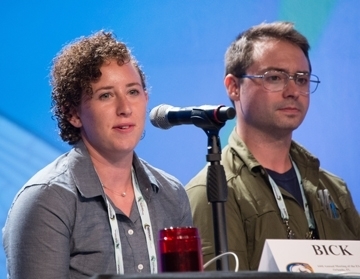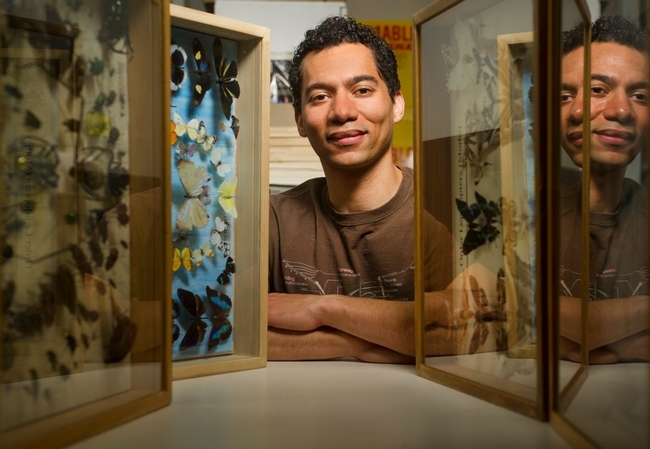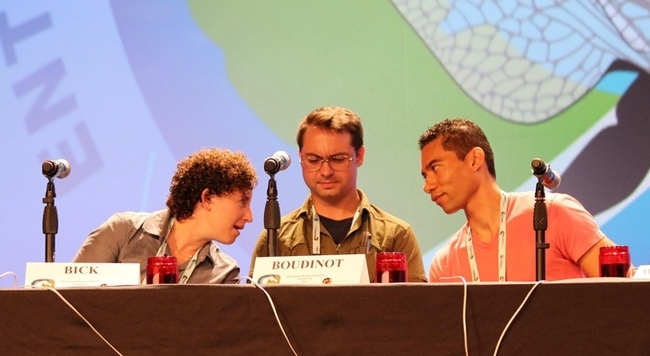
Which team--the UC Berkeley-UC Davis team or the Washington State University team--would win?
That was the white-knuckle scene at the Linnaean Games competition hosted by the Pacific Branch, Entomological Society of America (PBESA) at its meeting June 10-13 in Reno. The Linnaean Games are a lively question-and-answer, college bowl-style competition on entomological facts played between university-sponsored student teams.
The teams score points by correctly answering random questions. Per the rules, they often try to answer the question before it is completed.
Was the answer Dutch scientist Antonie Philips van Leeuwenhoek? Or not?
After hearing a portion of the question, WSU rapidly--and incorrectly--buzzed in the answer, Leeuwenhoek.
It was actually Jan Swammerdam.
The UC Berkeley-UC Davis Team emerged victorious. The team, captained by Ralph Washington Jr., a graduate student in public policy at UC Berkeley, (formerly a graduate student at UC Davis), included UC Davis doctoral students Brendon Boudinot, Zachary Griebenow and Jill Oberski, all of the Phil Ward lab, and Emily Bick of the Christian Nansen lab.
“Davis vs WSU was the final game of the night,” related Boudinot. “This went into Sudden Death as the teams were tied 90-90 after several UC Davis interrupts reduced their point total. We came back from DOWN to tie at about 15th question, and the sudden death question was specifically selected to be challenging. The key details were ‘Dutch ... microscopist from the 17th century.' WSU buzzed in on the interrupt and stated 'Leeuwenhoek,' which was incorrect, leading to their elimination. The correct answer was Swammerdam."
The complete question: What Dutch scientist, a microscopist, was the first to observe and describe red blood cells? As part of his anatomical research, Swammerdam (1637-1680) "carried out experiments on muscle contraction," according to Wikipedia. "In 1658, he was the first to observe and describe red blood cells. He was one of the first people to use the microscope in dissections, and his techniques remained useful for hundreds of years."
What a close competition! Congratulations to both teams!
PBESA will sponsor the UC Berkeley-UC Davis team at the National Linnaean Games at the Entomological Society of America's annual meeting, set Nov. 11-14, in Vancouver, Canada. Runner-up WSU (my alma mater!) also will compete.
Some of the questions asked at this year's PBESA Linnaean Games, as related by Ralph Washington Jr.:
Question: Name the fungal agent that grows naturally in soils throughout the world and causes white muscardine disease and is commercially packaged as a biological insecticide for the control of termites, whiteflies, and other insect pests?
Answer: Beauveria bassiana
Question: Name the process through which spiders use silk to fly and disperse.
Answer: Ballooning.
Question: Where are you most likely to encounter a rheophilic insect?
Answer: In moving streams.
UC Davis has done well in the Linnaean Games over the years. It won national championships in both 2015 and 2016; Washington captained both teams. Boudinot was a member of both teams, and Bick, the 2016 team.
Think you can answer some of the questions?
- Watch the 2016 National Linnaean Games Championship Round (won by UC Davis), posted on YouTube
- Watch the 2015 National Linnaean Games Championship Round (won by UC Davis), posted on YouTube
The list of national champions over the last five years:
2017
1st Place: Texas A&M
2nd Place: The Ohio State University
2016
1st Place: University of California, Davis
2nd Place: University of Georgia
2015
1st Place: University of California, Davis
2nd Place: University of Florida
2014
1st Place: North Carolina State University
2nd Place: University of Florida
2013
1st Place: University of California- Riverside
2nd Place: Mississippi State University
The Pacific Branch of ESA is comprised of 11 states (Alaska, Arizona, California, Hawai'i, Idaho, Montana, Nevada, Oregon, Utah, Washington, and Wyoming), plus U.S. territories and parts of Canada and Mexico.
As for the parent organization, ESA, it was funded in 1889 and is the largest organization in the world, serving the professional and scientific needs of entomologists and individuals in related disciplines. Its some 7000 members are affiliated with educational institutions, health agencies, private industry, and government. Members are researchers, teachers, extension service personnel, administrators, marketing representatives, research technicians, consultants, students, pest management professionals, and hobbyists.
Attached Images:

Ralph Washington Jr. captained the UC Berkeley-UC Davis Linnaean Games Team that won the regional championship at the 2018 PBESA meeting. He also captained the UC Davis Linnaean Games Teams that won the national championships in 2015 and 2016. (UC Davis Photo)

In this image from the 2016 national Linnaean Games championship round, UC Davis members (from left) Emily Bick, Brendon Boudinot confer with captain Ralph Washington Jr. (Photo by Chuck Fazio)